by Dennis Dalman
Some people in the Heritage Place neighborhood in north Sartell are upset that city mowing near a two-pond wetlands area is killing milkweed, a plant that is vital for the survival of the endangered monarch butterfly.
And it’s not only monarchs they’re worried about, said Laura Kerkvliet, a Sartell resident. Tree frogs, lady bugs, grasshoppers, moths and more small critters rely on milkweed too.
That mowing process has also had awful effects on painted turtles, some of whom were sliced up by the rotary blades of the big mowing machines.
“The turtles were in the grass and were cut and killed,” Kerkvliet said. “I have pictures from last summer that show how turtles were sliced apart.”
Heritage Place is located on Roberts Road behind the Coborn’s Super Store.
Kerkvliet, on behalf of concerned neighbors, has contacted city officials about the problem, but the mowing continued, she said. She also called the Minnesota Department of Natural Resources, but an employee there said the DNR has no jurisdiction over that area so Kerkvliet said she was told to start a public-awareness effort.
The Newsleader contacted Sartell Public Works Director John Kothenbeutel, who said yes, the city mows in some areas of that property but that it is necessary to get rid of noxious weeds, especially thistles.
“We have two ditch-mowers running until freeze-up time,” Kothenbeutel said. “We only mow by the right-of-ways.”
He acknowledged that it’s unfortunate about the milkweed plants but it would be virtually impossible to eliminate the high weeds and thistles by hand – without use of the mowers.
Although thistle is defined as a noxious weed and can cause problems, it can be a source of food for some birds, as well as bees, moths, wasps and beetles.
On a brighter note, Kothenbeutel noted the City of Sartell joined forces recently with counties and put in a 15-acre pollinator garden for butterflies, bees and other critters near the city’s southwest water treatment plant. That was accomplished with a Stearns County grant, with the city donating that land for the garden.
Kothenbeutel added there are many other green spaces in the city that are habitat for flora and fauna, including butterflies. Another example is the large areas of natural prairie grass that were planted years ago by city hall for environmentally healthy reasons.
Still, Kerkvliet and others keep wishing there was a way to stop the mowing. It is ironic, she said, that there are several signs posted by the city on that wetlands area. The signs state the following message:
Wetland Buffer
Per City Ordinance. No disturbance (mowing, filling or structures) in the wetland or buffer area are allowed.
This sign marks the upslope of a wetland buffer. The plantings downslope of this sign contain native trees, flowers, shrubs and grasses that provide food and shelter for birds and other wildlife.
The plants also help to hold soil to prevent erosion and filter nutrients from adjacent lawns to improve the quality of the water entering the wetland.
Why, Kerkvliet and others wonder, should the city violate its own advisory against mowing there, as the signs state?
When asked that question by the Newsleader, Kothenbeutel said the signs were purposely posted facing the direction of the neighbors who would then be reminded to protect that land, including possibly from one or more neighbors who might want to mow in near-the-ponds’ areas where they shouldn’t.
In an effort to protect monarchs, Kerkvliet and some others in the area, including her two children, collect milkweed plants that have monarch eggs on them, then take them home to raise them on the milkweed plants, then they release the hatched monarchs near the wetland ponds.
After one mowing by the city, they managed to find just three eggs in that area, which saddened her children – Cody, 8; and Emma “Mia,” 2.
Kerkvliet and her husband, Josh, moved to Sartell in 2008. She is employed by the Performance Improvement program at CentraCare.
Monarchs
Monarch butterflies, now on the Endangered Species list, are remarkable for their long migratory journeys. They are known to travel up to 3,000 miles from Canada and the northern United States all the way to the interior of Mexico, where they over-winter. Then in spring, a new generation hatches, and they travel back to the North again.
The development of a monarch from its egg on a milkweed plant is one of the most mysterious and fun-to-watch processes in nature. The entire process takes from 10 days to two weeks. First, a monarch lays eggs on the underside of a milkweed leaf. When a small white egg hatches, a very tiny caterpillar (striped white, black, yellow) emerges. It begins to eat the milkweed plant constantly, voraciously for days and nights as it quickly grows bigger and fatter.
Fully gorged from its eating, the caterpillar hangs upside down from a leaf branch and fastens itself securely with a sticky silk it makes. Eventually it begins to wiggle eerily as it slowly sheds its skin. What’s left is a blob of white that gradually turns into a beautiful jade-green waxy casing with a few gold dots toward the bottom. The green casing is known as a chrysalis.
Over a series of days, that chrysalis begins to darken to a purplish-black, and finally a shrunken-looking butterfly emerges and begins to slowly flap its wings, pumping the fluids throughout its body, gaining in size. At that point, it’s ready to fly and flutter away up into the big world.
Among the factors that endanger the monarchs are loss of its vital milkweed for growth and development, drought conditions, insecticides and herbicides, and habitat loss to overwintering sites in Mexico.
To counter the dwindling of monarchs, people are encouraged to plant milkweed and butterfly nectar plants so important to keep energy levels during their long migratory journeys. To find out more about how to help and the kinds of plants to plant, visit Bring Back the Monarchs Campaign at www.monarchwatch.org.
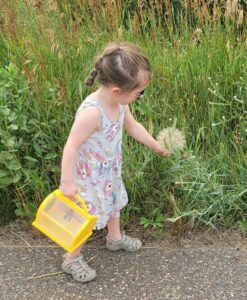
Emma Kerkvliet releases a monarch butterfly near her home in the Heritage Place neighborhood in Sartell.
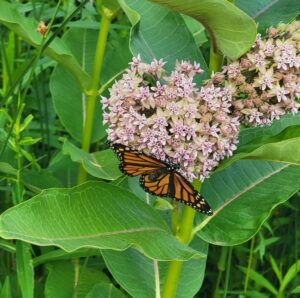
A monarch lights upon a milkweed-plant blossom in the Heritage Place neighborhood in north Sartell.
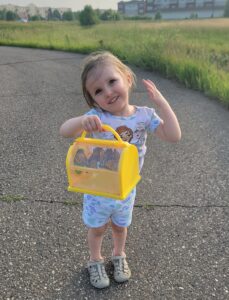
Emma Kerkvliet holds a basket of monarch butterflies that she is about to release after raising them from eggs at her home in the Heritage Place neighborhood of north Sartell.
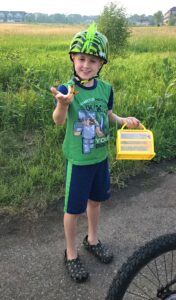
Cody Kerkvliet prepares to release monarch butterfly into the air.
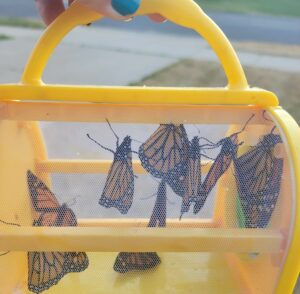
A bunch of monarch butterflies await their release from a cage carried by Cody and Emma Kerkvliet of Sartell.
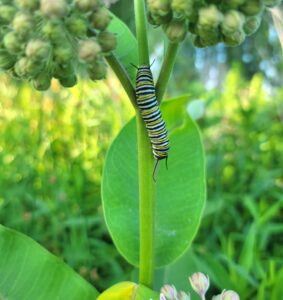
A monarch caterpillar crawls on a milkweed plant.
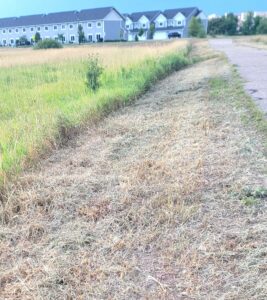
This is a swath that was mowed by the city in the Heritage Place neighborhood of north Sartell. The mowing is done in the pond-wetland area to rid right-of-way areas of noxious weeds, including thistles. In doing so, many milkweed plants are also destroyed.
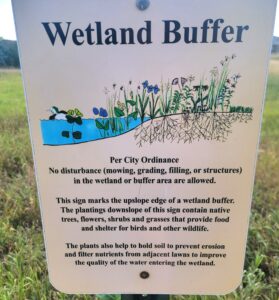
This is one of several signs posted in the Heritage Place neighborhood near a ponds-area in north Sartell.




